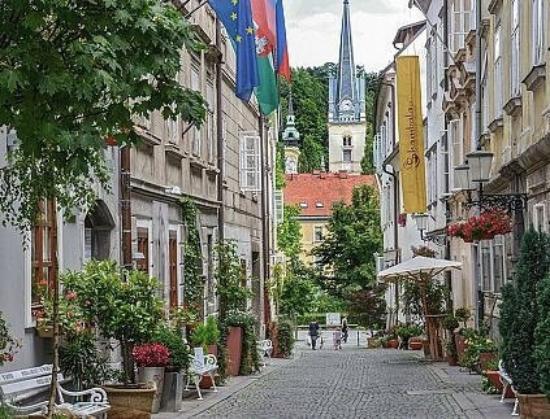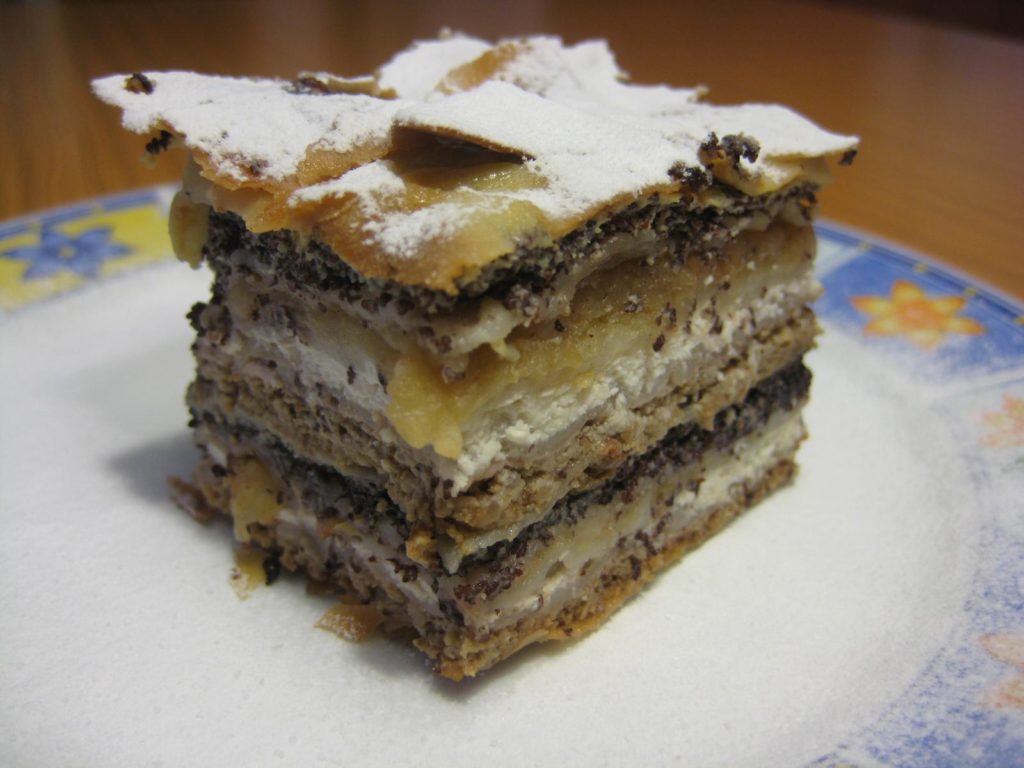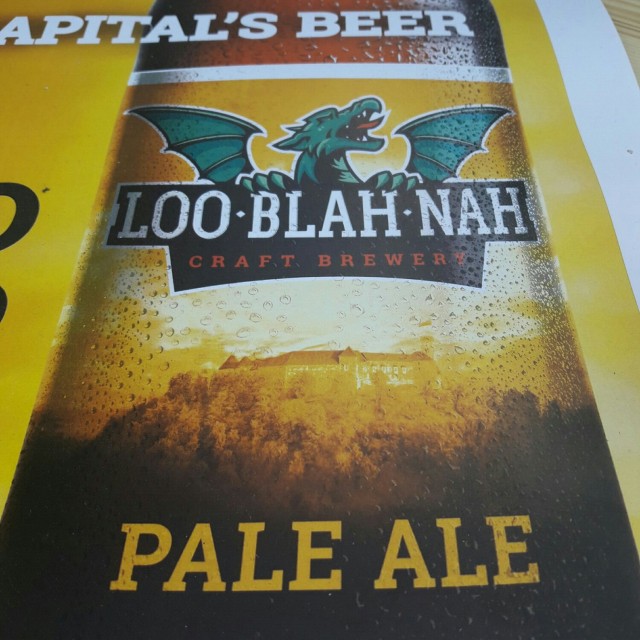We moved on to a place that Alenka called, the most beautiful and artistic street in Ljubljana – Križevniška ulica. These two blocks have been the traditional home for many artists, musicians, and writers. Here’s one look at it.
Coincidentally when we arrived, a crew was filming a promotional spot for what I assume was for some sort of “Things to do in Ljubljana” type show as we reached it. I remember watching in awe as the women strutted along the cobblestones over and over in their stiletto heels. (The slope is steeper than it looks.)
As you look at the photo, notice the white benches that line the street. These benches have bits of poetry printed on them and sometimes have a poem attached.
The song you are about to hear is from a Slovenian film, Cvetje v jeseni, that Alenka translated as Blossoms in the Fall. (On IMDB, it’s translated as Blossoms in Autumn.) As our violinist played, his performance gave rise to two additional coincidences.
This song drew the attention of a man in a nearby building who, when he came outside, told me that his house served as the Jewish Cultural Center and a synagogue. It was also a spot where the lead actress from Blossoms in Autumn, Milena Zupancic, was working that day. Unfortunately, she wasn’t present at the moment of our visit. Actors!
We crossed the river to the oldest part of Ljubljana where we gathered in a square where a linden tree once stood. (It has since been replaced by a fountain.) Though I couldn’t find the reason, the linden tree is considered a symbol of Slovenia. The country is filled with linden trees and many of them are several hundred years old so that might have something to do with it. I found this on the Slovenia.sl website,
Ancient linden trees can be found today in front of village churches, in castle yards, and in village or town squares. The linden tree marks the place where the village community met for social gatherings and where decisions on matters of common interest were made.
The music we heard here is called Lipa zelenela je (The linden tree turns green). As the violinist played, Damir quietly sang along. I found this recording of it by the Slovenski octet. If you’ve been reading along, some of the images in the video will look familiar.
Our tour, which began in the morning, included lunch. And, in yet another moment of synchronicity, we had lunch at Druga Violina the very spot where Diane and I had dined our first night in Ljubljana. It might have made for an ideal symmetry had this been our last meal in the city. (It wasn’t but more on that anon).
We had choices from a traditional Slovenian menu and at the end of the meal I had my first taste of a very traditional dessert called gibanica. This is a popular dish all over the Balkans and the Slovenian variant that we’d have is properly called prekmurska gibanica. It’s an outrageous multi-layered pastry containing poppy seeds, walnuts, apples, raisins, and ricotta between sheets of thin, flaky dough.
As tasty as it was, I preferred my fig-walnut ice cream.
After lunch, we finished our tour by walking down Mestni Trg and stopped in front of Mestna hiša or Town Hall. While the building itself has its own charms – it was originally built in a gothic style in the 15th century and renovated in a Venetian inspired Baroque design in the early 18th century – the more important element of the square is the replica of the Robba Fountain also known as the Fountain of the Three Carniolan Rivers.
The original Robba Fountain was installed in 1751 and has, since 2006, resided in the National Gallery. The fountain is considered among the most recognizable symbols of the city of Ljubljana and it holds deep cultural significance for the Slovenes.
In this photo, with the Town Hall immediately behind it, you can see one of the three male figures with a jug that were actually added sometime after the original installation of the fountain with its 10-meter-tall obelisk. These figures represent the ancient gods of the three main rivers of Carniola – the Sava, the Krka, and the Ljubljanica. They are also said to represent the three territorial units – Upper, Lower and Inner Carniola – with the steps symbolizing the Carniolan mountains.
We received our final and somewhat extended concert as our violinist sat on the steps of the Town Hall. This was also the most public of his concerts as many passersby – including a woman whose toddler implored her to stop – shared our enjoyment of his performance.
It was also here that I had a, “You must be kidding me!” moment. The tour finished in the afternoon of our last day in the tongue-twisting capital city of Slovenia (remember it’s lyoo-blyee-ah-nah). It was here that Alenka told me that even the residents tire of wrapping their tongues around it and often simply say Loo-Blah-Nah. I’d been trying to say the former for two and a half days and learned with half a day remaining that I could have used the much easier one. That’s worth a, “You’ve got to be kidding me!” isn’t it? Then as if to rub it in further, later that afternoon as I roamed around the city, I passed a pub that had a sign promoting this:
Loo-Blah-Nah. Seriously!?? The pub wasn’t open so, making matters even worse, I never got to drink any.
Here’s a silly ditty, You can sing it right away
The time has come for our farewell dinner. Of our group of 12, five are going on the trip extension to Budapest, one (Alison) is traveling to the Hungarian capital on her own and six are returning to the US tomorrow. We’ve had many meals included in this trip. Many of them, such as the dinners in our hotel when we arrived in the evening, were matters of convenience. With one exception, all the other included dinners were (understandably so) within walking distance of the hotel. (The exception was the dinner in Dubrovnik because the hotel was some distance outside the old city.)
From a culinary standpoint, I’d say the best of the included dinners were good but never memorable. The one exception would be our farewell dinner in Ljubljana. Unfortunately, this meal was memorable for the wrong reasons. While the evening had its share of good fun, I think most, if not all of us, would say it was the worst meal of the trip and one that fell far short of the descriptions Damir gave us on our return from Lake Bled.
I think the intent was to convey some sense of Slovenia as it had been under the Austrian part of Austro-Hungary because the meal and the atmosphere felt quite Germanic. As had been the case with so many of the previous meals, the staff greeted us with some sort of alcohol, perhaps a višnjevec, which is a sour cherry brandy. As had never been the case, the drinks were served outside the restaurant and someone walking by simply helped himself to one of the glasses intended for us.
The staff generally wore costumes that, to my eye, were more Bavarian than Slovenian. We had a small group that danced for us periodically through dinner. They were accompanied by an accordion. At some point, the dancing, beginning with the German Hat Dance became participatory.
Our group had both men and women and they turned the dance into something of a competition eliminating people who dropped hats as the music accelerated. We also danced some folk dances and had one that turned into a line dance and took us out into the street. I think, that while most of us enjoyed that part of the evening, I also think most of us would have preferred a better meal.
Tomorrow, Connie, Jackie, Geanie, Pat and I will crowd into a van with Damir and set off for Budapest. Alison, who will stay in Hungary for two weeks, is flying there on her own and everyone else will set out for home. Since both Hungary and Slovenia are part of the Schengen Zone, we’ll cross the border without passing through customs or immigration.
Oh, if you’re wondering, here’s a music reference key:
Roll up, Roll up for the musical tour refers to the Beatles’ Magical Mystery Tour.
Let’s start at the very ending is intended to evoke Do, Re, Mi from The Sound of Music.
Castle in the clouds was drawn from Castle on a Cloud from Les Miserables.
Some days are diamonds, some days are rocks is from Tom Petty’s Walls.
…nothing can capture a heart is from Abba’s Thank You for the Music
Here’s a silly little ditty, You can sing it right away is from Too Fat Polka




